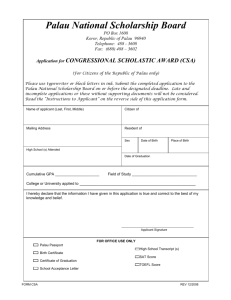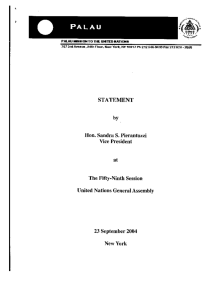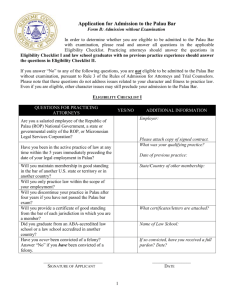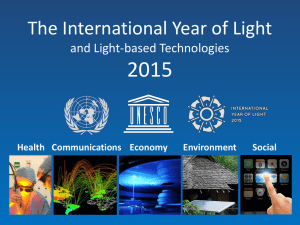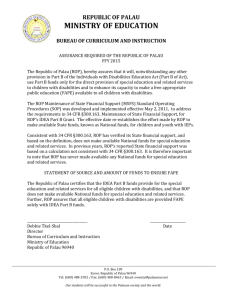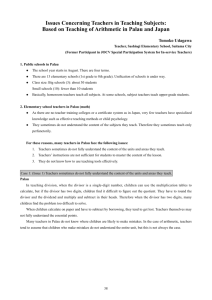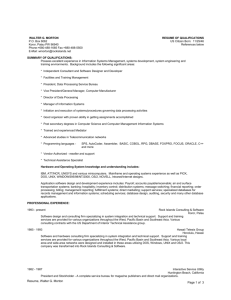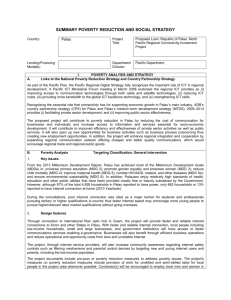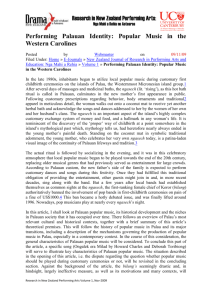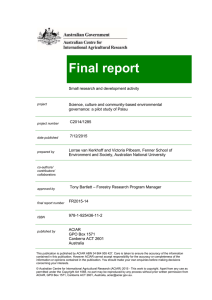File - TESOL Capstone ePortfolio
advertisement
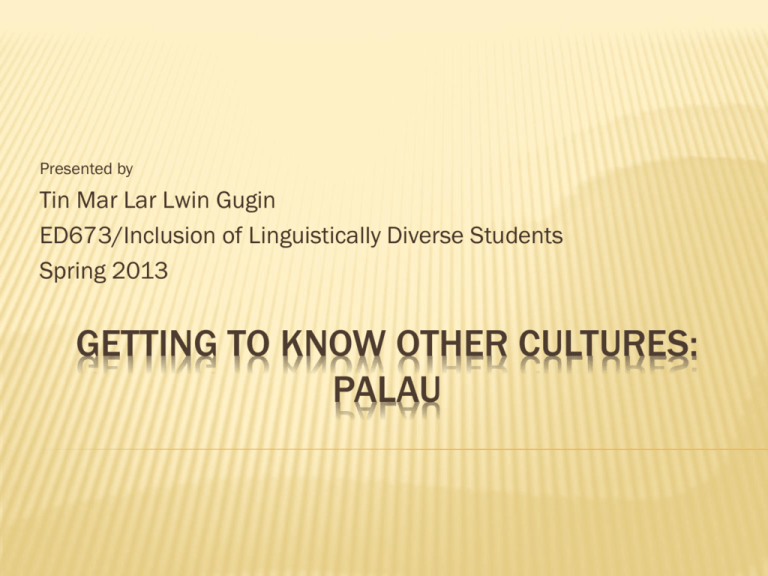
Presented by Tin Mar Lar Lwin Gugin ED673/Inclusion of Linguistically Diverse Students Spring 2013 GETTING TO KNOW OTHER CULTURES: PALAU LOCATION Consisted of small islands in the northern Pacific Ocean, Located in Oceana, southeast of the Philippines with the total area of 459 sq/km Varies geologically from the high, mountainous main island of Babelthuap to low, coral islands mainly fringed by large barrier reefs (Palau. CIA. The World Factbook) ON THE MAP AND THE NATIONAL FLAG HISTORICAL CONTEXT The original settlers – from Indonesia Was explored by the Spanish navigator Ruy López de Villalobos in 1543 Remained under nominal Spanish ownership for more than 300 years Was sold to Germany in 1899 Japan occupied Palau during World War I and received a mandate over the islands until the U.S. seized them during World War II HISTORICAL CONTEXT (CONTINUED) After the war in 1947, the islands became a UN trusteeship, administered by the U.S. In 1992, Palau signed a Compact of Free Association with the U.S. Economic aid was provided by the U.S. in exchange for the right to build and maintain U.S. military facilities in Palau Became a sovereign state in 1994 PEOPLE AND RELIGIOUS BELIEFS a mixed population of Malay, Melanesian, Filipino, and Polynesian ancestry due to the proximity to southeast Asia and Oceania Palauans (about 70% of the population) are predominantly Micronesian with a mix of Malayan and Melanesian strains. There are minorities of Filipinos, Chinese, and other Asians. Linguistically and culturally Palau shares prehistoric links with the peoples of the Philippines and eastern Indonesia Roman Catholicism and Protestantism are the predominant religions. LANGUAGE AND CULTURE Palau comprises several cultures and languages Palauan an Austronesian language of a Western subgroup Along with Chamorro (Mariana Islands), is considered separate from the other Micronesian and Pacific languages grouped under the label "Oceanic." English and Palauan are official languages; elders also read and speak Japanese. The Palauan language incorporates Spanish, German, Japanese, and English loanwords. EDUCATIONAL HISTORY Traditional schools, as with other cultures, include chanting and story-telling was a way of passing on morals, values, and knowledge. Under the Spanish control, in 1891, Capuchin missionaries started a Catholic school in Palau, promoting the Christian way of living. During the German control, in 1902, the first school for policemen was opened by the Germans, the first vocational school in Palau During the Japanese occupation, the first formal public school system was introduced in Palau, and “unlike Spain or Germany, they set up a well organized school system throughout the islands of Micronesia” (Quoted by Luka, 2011). EDUCATIONAL HISTORY (CONTINUED) Under the American control, the U.S Navy introduced a curriculum that included Palauan language, art, English (reading and writing). In 1962, the Kennedy Administration introduced the Accelerated Elementary School Program; English as the language of instruction and ESL became available in Palauan schools Due to the stagnant economy during the early years of the American administration, the Palauans sought employment and education in the United States and its Pacific territories EDUCATIONAL HISTORY (CONTINUED) A process of Palauan out-migration began There are now second- and third-generation emigrants, especially in Guam, Saipan, and Hawai`i, have well-established social networks that facilitate education and employment opportunities for the extended families spread across Palau, Guam, the Northern Marianas, the United States, Japan, China, and the Philippines EDUCATIONAL HISTORY (CONTINUED) Since the 1960s, Palauan students have had access to US scholarships and loans for college and other tertiary training. The educational level of the overseas Palauans is high, and many hold professional and managerial positions Those who hold skilled or semi-skilled positions enjoy pay levels higher than those available in Palau. (Nero, Murray, and Burton, 2000) PALAU HIGH SCHOOL First public high school in Palau and reestablished in 1962 Is accredited by WASC Enlists students pursuing a secondary education in academics or vocational trade www.palaumoe.net/phs/ Palau High School.JPG commons.wikimedia.org PCC – PALAU COMMUNITY COLLEGE Micronesian Occupational College that was founded in 1969 as a two-year post-secondary vocational/technical institution became Palau Community College in 1993 Has got accreditation from WASC for the past 30 years The mission statement, “Palau Community College is an accessible public educational institution helping to meet the technical, academic, cultural, social, and economic needs of students and communities by promoting learning opportunities and developing personal excellence.” https://bigfuture.collegeboard.org/college.../palaucommunity-colleg... CORE VALUES “According to the research of the Palau Society of Historians and the Bureau of Arts and Culture (2006), there are eight fundamental principles and components that were taught to Palauan children in their homes and clubs (p.3-4).” Respect Responsibility Occupation Obedience, Kindness, and Perseverance Visits to Kin and Others Humility and Verbal Conduct Care and Compassion Concern for the Needs and Problems of Family Quoted by Virginia Luka (2011) in her paper” Palau: Impacts of Education and Cultural Changes.” ROLES OF FAMILY MEMBERS AND THEIR IMPLICATIONS FOR THE CLASSROOM Matrilineal society “The basic unit is the telungalek —people descended from one woman” (The culture of Palau) Picture from pacificislandtravel.com ROLES OF FAMILY MEMBERS AND THEIR IMPLICATIONS FOR THE CLASSROOM (CONTINUED) The components of the core values taught to the children since at a very young age play the major role for the related perspective Membership in a clan is passed down generation to generation from a mother’s line Both men and women may rightfully be offered a title in a clan passed through the female side of a family. When a chief died, his title returned to the woman in his lineage Various members of a child’s family were in charge of teaching proper behaviors such as a child’s maternal uncles, as well as female titleholders DISCIPLINE AND BEHAVIOR Disciplines and behaviors also reflect the core values “Self-sacrifice for the good of the family was considered better than individual advancement” (Luka, 2011) Children are given everyday responsibilities in their home, clan, and society Youths learned from each other while performing different assignments and occupations that were given depending on their personal background knowledge and skills DISCIPLINE AND BEHAVIOR (CONTINUED) They demonstrate kindness towards their village by providing financial support and practiced perseverance by working together Older people teach core values to the younger by example Children are expected to learn who their relatives and familial responsibilities are, including caring for family members (especially elders and the sick) Children are also taught to be humble and to speak properly to others. IMPLICATIONS FOR THE CLASSROOM Both collaborative and vicarious learning styles are evident in Palauan culture Implicates “Creating a Sense of Belonging” (Peregoy & Boyle, pp. 16-17) First and foremost importance to help the new Palauan students feel that they are “part of the social fabric of the class” Home group One-to-one attention of the personal buddy Repetition of class routines within a meaningful concrete context Context-embedded instructions PALAUAN ORAL LANGUAGE HISTORY AND IMPLICATIONS FOR CLASSROOM “For students learning English as a second language in school, oral language development plays a key role “ (Peregoy and Boyle) They discuss the importance of oral language development in academic success “Retelling” is especially significant for Palauan students’ English language learning and success in school “Culturally compatible in an oral society” especially retelling the story to one’s partner or in a group “builds upon the collaborative nature of Pacific Islanders” (Stoicovy, UOG) Context-embedded as well as culturally appropriate content-based lesson plans will be most helpful FOOD AND ITS SIGNIFICANCE IN THE PALAUAN COMMUNITY Traditionally, men provide protein, women provide starch Each clan has certain recognized food taboos Special foods for titled individuals and for pregnant and lactating women The extended family system was organized around a series of clan exchanges of food and related valuables during special occasions soft or hard taro, tapioca, or rice, pork and fish Japanese and American foods, and recent additions various cuisines of China, the Philippines, and Korea FOOD AND ITS SIGNIFICANCE IN THE PALAUAN COMMUNITY Palauan tapioca - it's ground down from the root and mixed with some sugar and water, then stuffed inside frond leaves, sewn up with twine, then boiled for awhile. It's a great-tasting starch (Davesensei.blogspot.com Palau+Emadch2-2275.jpg) REFERENCES Culture of Palau: Countries and Their Cultures. Retrieved from http://www.everyculture.com/No-Sa/Palau.html Luka, Virginia. (Spring 2011). Palau: History of Education and Cultural Impacts. McNair. Scholars Journal, 7, 45-60. www.sou.edu/mcnair/documents/LukaCV.pdf Nero, Karen L; Murray, Fermina Brel; Burton, Michael L. (2000, september 22). The Meanings of Work in Contemporary Palau: Policy Implications of Globalization in the Pacific. The contemporary Pacific. Retrieved from http://www.infoplease.com/encyclopedia/world/palau.html#ixzz2PZmR2M 4Q Palau – CIA – The World Factbook. Retrieved from https://www.cia.gov/library/publications/the-world-factbook/geos/ps.html Peregoy, S. Boyle, O. (2008). Oral Language Development in SLA. Reading, Writing, and Learning in ESL (pp. 115-150). Boston: Pearson. Stoicovy, C. E. Culturally Responsive Instruction for Pacific Islanders: Helping to Close the Gap. SOE. College of Professional Studies. UOG
